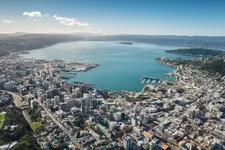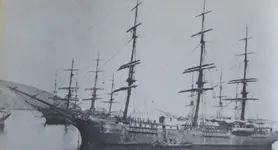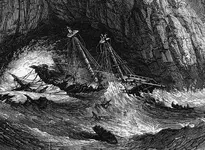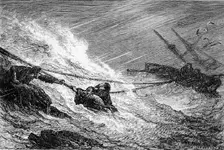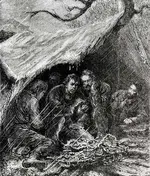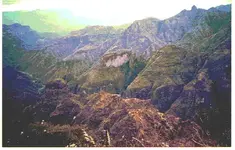Once again I will continue the yarn. I hope you are all comfortable?
Before this terrible horrific disaster occurred, Captain Laughlin had secured a cargo and some passengers re-engaged a full crew and left Melbourne on 3rd May 1866, onward-bound for London via Cape Horn with 83 souls on board, including a number of women and children.
The wife of Chief Officer Bartholomew Brown was signed on as a member of the crew and did at times, act as a stewardess to the women passengers. Another passenger who had paid her fare was also signed on as a member of the crew was Mary Anne Jewell, wife of Able Seaman Joseph Jewell and this arrangement was to allow the married couple to associate together. Surprising they both Anne and Joseph survived as you can see in the picture below.
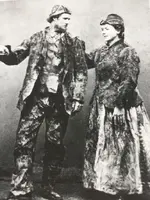
There were 15 people in cabin class, including Mrs. Oat and her four children, one of them a babe in arms. In the second class or steerage accommodation, there were 41 people including 11 children two babies and four women. The crew comprised American officers, English, Scots American and Irish seamen and with the captain, they numbered 27.
In the steerage accommodation was a seaman turned gold miner named James Teer who was carrying, in a specially made body belt, 300 golden guineas, the result of his endeavors in the Australian goldfields. He was not the only one to be carrying his personal wealth with him, many of the passengers were gold miners who had no trust in banks and were carrying fortunes in gold dust, nuggets, coins or bars. Gold also made up a small portion of the cargo of the General Grant.
Most enticing of all my friends there were 2576 ounces and six pennyweights (around 70 kilograms) of gold bars in Captain Laughlin’s safekeeping. Also on the manifest was 30 tons of spelter, a cheap yellow metal used to make decorative items. That metal was to cause considerable speculation in the years to come as to whether it was really gold ore or even gold bars. However for me I think more wishful thinking than reality? The remainder of the cargo was 2,000 bales of wool, hides hardwood, other timber, and assorted general cargo.
After the loss of general grant and terrible suffering the survivors went through until their rescue. They was left destitute. local people raised some money by charitable donations. The survivors was so poor they did not even have clothes other than the seal skins they had sown themselves as caster ways.
To understand this my friends of their plight you would begin to understand why one of men would return after from being rescues to search for the ship and the gold?
There was much speculation about the gold in the wreck and it wasn’t long before an expedition was organized to return to the Auckland Islands, with the intention of recovering the treasure and James Teer was to be the guide. The party set out for the Auckland’s aboard the steam tug Southland, however, rough seas and high winds prevented them from putting their diver into the water and, with fuel running low, they returned to NZ empty-handed.
At that stage, Teer gave up the treasure hunt to live a reclusive life on the west coast of NZ’s South Island, but his place as the guide was taken up by one of the surviving passengers. David Ainsworth, joined Captain Wallace and the seven-man crew, including a diver, of the topsail schooner Daphne and once at the island it was decided to anchor the Daphne and load their whaleboat with provisions and set off, with six men to try to locate the cave, but somewhere along their path, tragedy overtook them and they were never seen again.
Five weeks later the three men left behind realized their fellow crewmen were not coming back, the General Grant had claimed six more victims and the gold was as elusive as ever. The Daphne’s cook took command and managed to get the vessel back to New Zealand safely.
Once again the hungry cave of death claimed more victims.
However it dis not stop others from trying.....
50 years had passed before an expedition managed to get a diver into the cave. Percy Catling, an Englishman, dived in the cave but all he found were rocks with pieces of wood sticking out from under them, leading to the belief that over the years the cave roof had fallen and buried the wreck.
Yet the lure of gold is strong my friends?
50 more years were to pass before, in 1975, a well-organized expedition, led by an ex-RN diver, Commander John Gratton and including experienced NZ commercial wreck divers, Kelly Tarlton and Malcolm Blair set out to finally locate the wreck and the elusive gold aboard the research vessel Acheron. During that first year they were disappointed to find how many caves, there were large enough to swallow a 1,000-ton ship, but eventually, they discovered a wreck in a cave which was covered in rocks but looked very promising. Unfortunately, they had no lifting gear to move the rocks, so were obliged to leave the wreck, and the elusive gold, undisturbed.
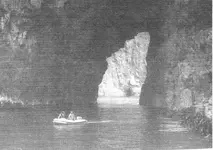
To compounds the problems my friends there is many caves that was big enough to swallow a sailing ship on the west coast of the island but which one?
In 1986 Malcolm Blair and his business partner Bill Day, now in possession of their own diving company and a suitable dive vessel, the catamaran Little Mermaid, decided to continue the search for that elusive gold and looked around for like-minded treasure seekers.
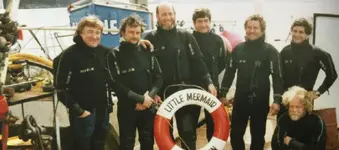
The new dive team worked hard for two weeks, sucking out sand to expose the wreck, only to find the hull was made of iron, not wood and turned out to be the French barque Anjou, lost in thick fog in 1905. They were then obliged to swim the length of the west coast searching for another cave and another wreck. The weather was good and the visibility underwater was an incredible 30 meters. Eventually, they located a cave, which they christened ‘the cave of death’, that fitted the description, left by James Teer and which on inspection contained pieces of wreck. Encouragingly they found some coins of the right date, and other ships artifacts, at last, they were really on to the wreck of the General Grant and her elusive fabled treasure?
The divers felt that at last, they were close to being rewarded for all their hard work and capital outlay but they were wrong, fate was about to step in once again and kick them in the teeth. On the 16 February 1986, hundreds of miles north in the Marlborough Sounds the Russian cruise liner Mikhail Lermontov struck a rock, started taking on water and was in danger of foundering. Later that night the order was given to abandon ship and a call went out for assistance. The Little Mermaid, one of the very few salvage vessels in New Zealand, was obliged to immediately leave the Auckland’s in response to the SOS to assist in the rescue, however, by the time they arrived the Mikhail Lermontov had sunk with the loss of one Russian crewman.
However the Little Mermaid divers spent months doing salvage work and pumping out oil from the liner and by the time their tasks were completed, the weather window for that year had closed and the gold remained as elusive as ever.
After their hectic salvage work on the Mikhail Lermontov that group of divers lives, moved on, and some of them never returned to the Auckland Island, although a few stalwarts did, aboard the refitted and renamed Little Mermaid, now appropriately called Seawatch. In 1995 Bill Day and a group of 15 keen treasure divers returned to search for the gold. It was an ambitious, privately funded and properly equipped expedition and the plan intended them to stay on-site for ten weeks.
With the experience they had gained from previous trips they were able to lift rocks as heavy as 25 tons and move them out of the cave. Although they found many interesting articles, including gold and silver coins, they did not locate the elusive gold.
However, Bill Day, the youngest member, was not prepared to give up and in 1999 he returned to the site aboard the Sea Surveyor with a team of 11 divers, but of the 26 days at the Auckland Islands, the weather only permitted them to dive for three days and the gold remained elusive.
In 2000 Bill returned once again to the Islands aboard the Russian icebreaker Spirit of Enderby accompanied by his family and a number of friends in what was more of a ‘jolly’ than a serious diving expedition. There were divers onboard and they set out in the ship’s boats to dive two sites, Bill had designated, but that elusive gold eluded them yet again.
Throughout the history of the General Grant wreck, there have been so many other expeditions,about 28 at least all in effect a failure. The coins found by Bill Day turned out to far two early for the General Grant in fact evidence another shipwreck in the cave. Research point out a ship that went missing from the 1830's called the "Rifleman" Disappeared without trace. The artifacts found point out to wreck of the 1830's? Here is picture of bill day with some 1830 coins found in the cave below.

But questions remains my friends was it the right sea cave they searched?
Coffee?
Kanacki



